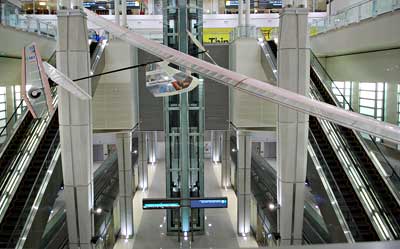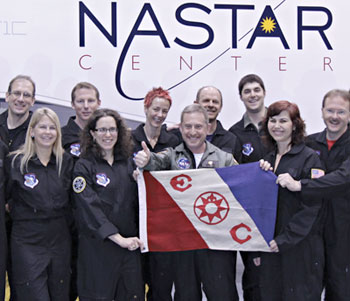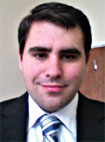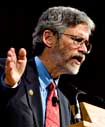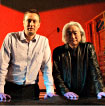
JANUARY 2010In this issue: |
||
1. Daedalus in DCAfter many years of display in Boston's Museum of Science, AeroAstro's famed human-powered aircraft Daedalus 87 has a new home worthy of its place in the annals of aviation and engineering landmarks. The craft is now on loan to Dulles Washington International Airport where it is prominently displayed in Terminal B above the new AeroTrain depot. AeroAstro and the MIT Museum collaborated on the loan. The funding and expertise that made the move possible were generously provided through alum John Langford, original manager of the Daedalus project, and Aurora Flight Sciences Corp., which he founded. Aurora and AeroAstro maintain a strong strategic relationship, cooperating on an ever-growing array of projects. Daedalus 87 was the first of two Daedalus aircraft constructed in 1987. It served as a backup to Daedalus 88 (in pieces at the Smithsonian), which flew from Crete to the island of Santorini (115 km) and holds records for human powered aircraft distance and duration
Daedalus 87 in its new home at Dulles Washington Airport. |
||
2. Wagner, Newman ready for (sub)orbitFollowing a two-day January program of classroom instruction, altitude chamber training, multi-axis centrifuge training for launch and reentry accelerations, and distraction factor exercises, AeroAstro Lecturer Erika Wagner and Professor Dava Newman successfully completed suborbital astronaut training at the National Aerospace Training and Research Center in Pennsylvania. In addition to physiology training simulating the conditions that scientist-astronauts will experience during missions to 100 km altitude, the course provides an overview about suborbital research. "This is becoming real," Wagner says. "In the next few years, I'll be able to design and fly my own science into space. Repeatedly, if need be. That's a bit different from the Space Station."
|
||
|
3. Barrett to join AA faculty
|
|
4. TALARIS hops through reviewThe TALARIS (Terrestrial Artificial Lunar And Reduced gravIty
|
||
|
5. New AeroAstro video postings on MIT WorldThree new postings of AeroAstro videos are on MIT World. "The Next Giant Leaps in Energy, Environment and Air Transportation" is the second of three installments from last summer's Giant Leaps seminar celebrating the 40th anniversary of the moon landing and features an intro by presidential science and technology Advisor John Holdren. In "The Next Giant Leaps in Space Exploration," the third installment, panelists predict and suggest directions the nation’s public and private space programs might take. These joins the previously posted "Apollo: Reflections and Lessons." The MIT Museum's December 8, 2009 program "Humans in Space," lead by Professor Dava Newman reviews how humans and robots will work together in missions throughout the solar system.
|
|
|
6. News briefs
Professor Brian Wardle and his group have taped several sequences for the new Science Channel series "Sci Fi Science." Wardle discusses carbon nanotube synthesis and demonstrates the process for synthesizing these unique materials, and their integration into large-scale materials and devices. The Science Channel series is centered around host Dr. Michio Kaku's theme of "Physics of the Impossible," where CNTs are identified as having both practical and far-out, applications. The taping was done in the TELAMS lab, using research capabilities developed by Wardle's NECST Consortium. Eight AeroAstro students are participating in the Operations Internship Experience, a January program sponsored by Massachusetts Space Grant and taught by Raji Patel and Jeff Hoffman, introduces students to the relationship between design, cost and operations. The students attended Kennedy Space Center briefings and operations tours and shadowed operational groups. Participants are Kwami Williams, Jillian James, Carla Perez Martinez, Ezekiel Willett, Natasha Bosanac, Andrew Wang, Charlie De Vivero, and Wendy Pino. |
|
7. Honors and recognitionMass High Tech newspaper has named Professor Dava Newman as one of its 2010 “MHT Women to Watch.” The 11 women selected as honorees are inventors, entrepreneurs, mentors, and community leaders, viewed as future leaders in their respective fields, including biotech, robotics, software, and cleantech. She will be profiled in the March 17 MHT issue. Newman also appears on the PBS Nova Web site in the Secret Lives of Scientists section. Grad student Chad Lieberman has been awarded the Kambourides Fellowship in Computational Engineering. The fellowship covers tuition and fees for a year, and provides a stipend. In awarding the fellowship, emphasis is placed on fundamental research with potential long-term substantial impact on the foundations of computational engineering, and student accomplishments, quality, growth potential, and communication skills. |
||
If you know of events, honors, activities, or other information you'd like to see in the next issue of AeroAstro enews, please send to wlitant@mit.edu — we'd be pleased to include your submissions.Catch the latest AeroAstro news on Twitter. |
||
© 2010 MIT Department of Aeronautics and Astronautics. All rights reserved. |
||
